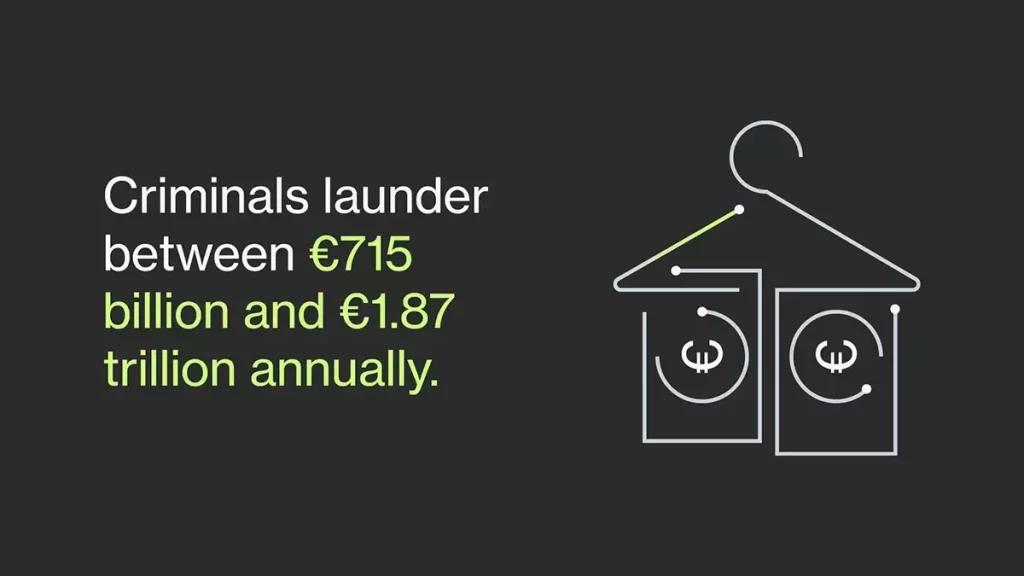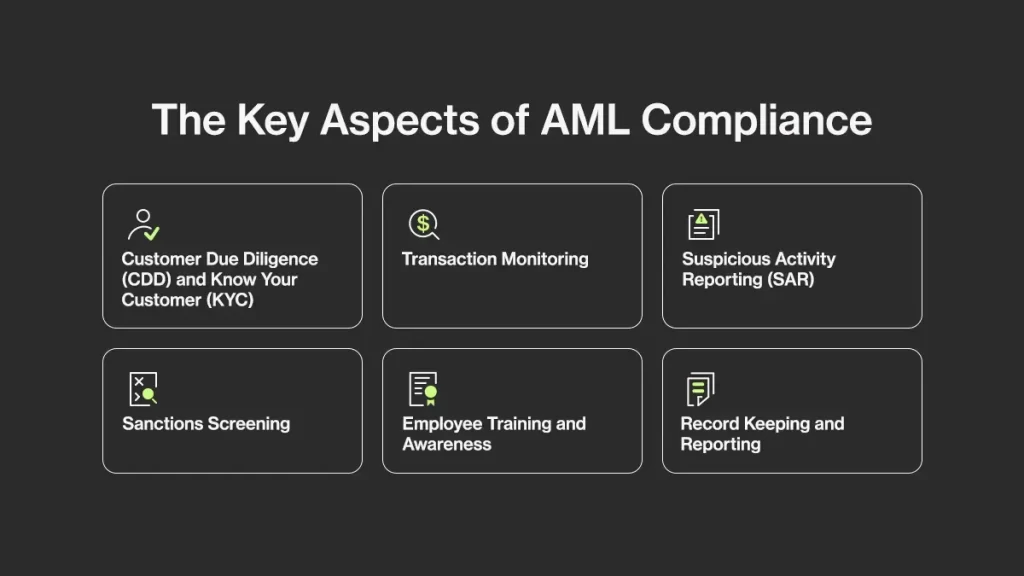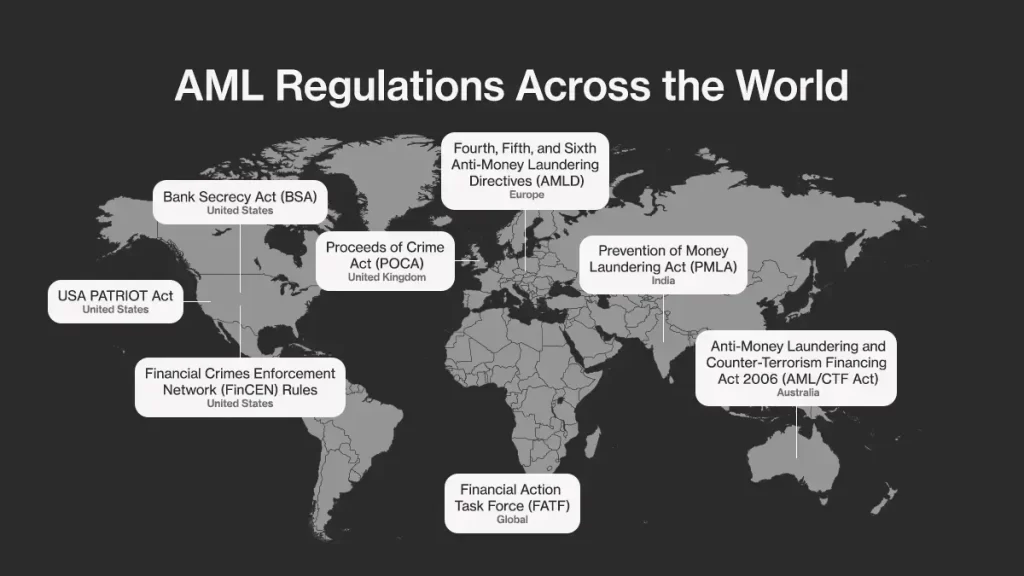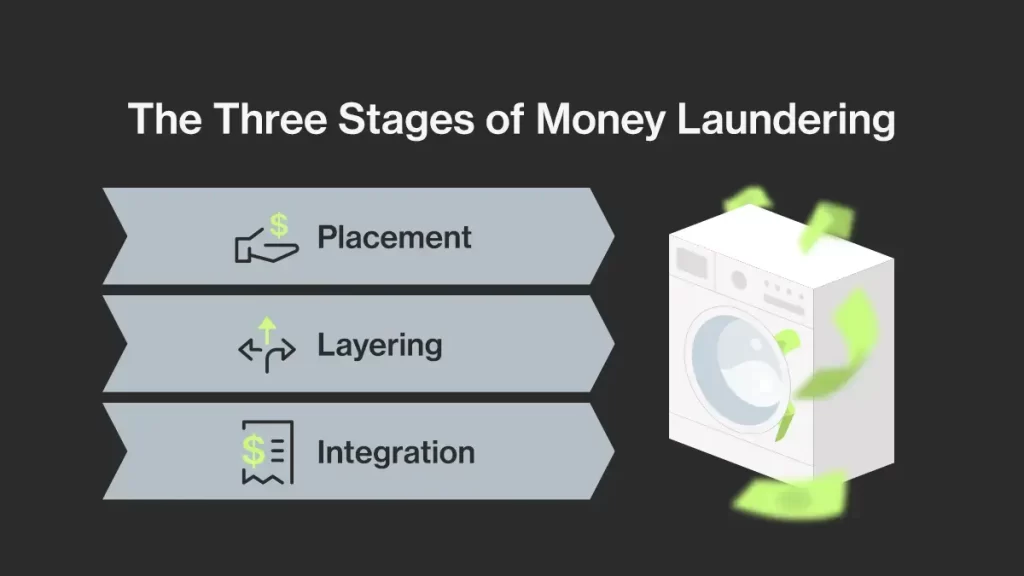Money laundering is not a new practice. For a long time, criminals – especially organized crime groups – have used money laundering schemes to conceal the true source of their illicit funds. With the rise of various financial solutions such as cryptocurrency, neo-banks, and e-wallets, combating money laundering is not an easy feat and requires risk-based procedures. As a result, regulators introduced new anti-money laundering regulations in order to prevent money laundering, increasing pressure on regulated industries. According to the United Nations Office on Drugs and Crime, criminals launder between €715 billion and €1.87 trillion annually. In any case, Anti-Money Laundering (AML) regulations are essential to honest business practices.

The Key Aspects of AML Compliance

The key aspects of AML compliance involve a set of essential processes and practices designed to detect and prevent money laundering and financial crimes, as well as monitor customer relationships. These include:
Customer Due Diligence (CDD) and Know Your Customer (KYC): Organizations must verify the identity of their customers and assess the potential risks they may pose, ensuring that they are not involved in illicit activities. This process involves collecting personal information, conducting background checks, and as well as conducting ongoing customer due diligence.
Transaction Monitoring: Financial institutions must continuously monitor transactions for suspicious activities, such as unusually large deposits, rapid movement of funds, or transactions involving high-risk countries. Automated systems help detect patterns or anomalies that may indicate money laundering.
Suspicious Activity Reporting (SAR): If suspicious transactions are identified, organizations must report them to the relevant authorities. This includes filing Suspicious Activity Reports (SARs) with agencies like FinCEN or other local regulators, ensuring that the authorities are informed of potential financial crimes.
Sanctions Screening: AML compliance requires businesses to screen customers and transactions against various sanctions lists, including those related to Politically Exposed Persons (PEPs) and individuals/entities subject to international sanctions. This helps avoid doing business with high-risk individuals or organizations.
Employee Training and Awareness: AML compliance programs must include ongoing training for employees to ensure they understand how to detect suspicious activity and comply with regulatory requirements. Employees should be well-equipped to handle AML responsibilities and stay informed about the latest regulations.
Record Keeping and Reporting: AML regulations require businesses to keep detailed records of transactions, customer information, and reports submitted to authorities. This ensures that organizations can provide evidence of their compliance efforts if audited or investigated by regulators.
AML Regulations Across the World

AML regulations are essential to protect financial systems, combat illicit activities, and promote economic stability. They vary across jurisdictions but are often aligned with international frameworks like FATF Recommendations to ensure consistency and global cooperation in the fight against money laundering.
Financial Action Task Force (FATF) Recommendations
The FATF is an intergovernmental organization that develops global AML and Counter-Terrorist Financing (CTF) standards. Its recommendations provide a comprehensive framework for countries to establish strong AML systems. These recommendations focus on:
- Customer due diligence (CDD) and beneficial ownership.
- Sanctions implementation.
- International cooperation and information sharing.
Countries are regularly assessed by FATF through mutual evaluations to ensure compliance.
Bank Secrecy Act (BSA) – United States
The BSA is the cornerstone of AML regulation in the United States. Enacted in 1970, it requires financial institutions to:
- Maintain records of cash transactions over $10,000.
- File Suspicious Activity Reports (SARs) when suspicious activity is detected.
- Implement AML compliance programs. The BSA works in conjunction with other U.S. laws like the Patriot Act to strengthen AML efforts.
USA PATRIOT Act – United States
Passed after the 9/11 attacks, the Patriot Act significantly expanded AML regulations to combat terrorist financing. Key provisions include:
- Enhanced due diligence for foreign financial institutions.
- Prohibition of accounts with shell banks.
- Sharing of information between financial institutions and the government (Section 314).
Fourth, Fifth, and Sixth Anti-Money Laundering Directives (AMLD) – European Union
The EU’s AMLDs are a series of legislative frameworks aimed at unifying AML efforts across member states. Highlights include:
- 4th AMLD: Introduced risk-based approaches and requirements to identify beneficial owners.
- 5th AMLD: Expanded AML requirements to cover cryptocurrencies, prepaid cards, and high-value goods. It also improved transparency for beneficial ownership registers.
- 6th AMLD: Focused on harmonizing AML offenses and penalties across the EU and holding individuals accountable for aiding money laundering.
Proceeds of Crime Act (POCA) – United Kingdom
The Proceeds of Crime Act 2002 criminalizes money laundering and empowers law enforcement to recover illicitly obtained assets. POCA places obligations on businesses, including:
- Reporting suspicious activity.
- Seizing or freezing assets suspected of being proceeds of crime.
Anti-Money Laundering and Counter-Terrorism Financing Act 2006 (AML/CTF Act) – Australia
This legislation establishes AML and CTF measures for financial institutions, casinos, and other regulated entities. It mandates:
- Customer identification and verification.
- Reporting of suspicious and large cash transactions to AUSTRAC, Australia’s financial intelligence agency.
Prevention of Money Laundering Act (PMLA) – India
The PMLA 2002 is India’s principal AML law. It criminalizes money laundering and requires financial institutions to:
- Verify customer identities.
- Maintain transaction records.
- Report suspicious activity and cash transactions to the Financial Intelligence Unit-India (FIU-IND).
Financial Crimes Enforcement Network (FinCEN) Rules – United States
FinCEN, a bureau of the U.S. Treasury, issues regulations that support the BSA. These include:
- Customer identification requirements.
- Suspicious activity and currency transaction reporting.
- Beneficial ownership rules (the “CDD Rule”).
The History of AML Compliance
Early Efforts (1930s–1970s)
The concept of Anti-Money Laundering (AML) compliance began taking shape as nations recognized the impact of organized crime and illicit financial activities. During the 1930s, the U.S. government implemented the first anti-money laundering measures to combat organized crime’s use of cash to finance illegal activities. However, these efforts were limited in scope and enforcement.
In 1970, the Bank Secrecy Act (BSA) was enacted in the United States, marking a major milestone. The BSA required financial institutions to keep detailed records of transactions and file reports for cash transactions exceeding $10,000. This was the first attempt to monitor and trace potentially suspicious activities within the financial system.
The Globalization of AML (1980s)
As financial systems became more interconnected, so did opportunities for money laundering. The 1980s saw a rise in drug trafficking and other transnational crimes, prompting governments to adopt stricter AML measures.
In 1989, the Financial Action Task Force (FATF) was established by the G7 countries to create a coordinated global response to money laundering. FATF’s 40 Recommendations became the foundation for modern AML practices, urging countries to implement consistent standards.
Expansion to Terrorist Financing (1990s–2000s)
During the 1990s, efforts expanded to include the fight against corruption and organized crime beyond narcotics. The European Union introduced its first AML directive in 1991 to align member states’ efforts with FATF standards.
The events of September 11, 2001 marked a turning point. Governments realized the connection between terrorism and financial crime. The USA PATRIOT Act was introduced in the United States, strengthening AML laws to include counter-terrorist financing (CTF). Globally, AML regulations were updated to address terrorist financing risks, resulting in stricter controls and international cooperation.
Focus on Transparency and Beneficial Ownership (2010s)
The 2010s brought a shift toward greater transparency in financial systems. High-profile scandals like the Panama Papers (2016) highlighted the misuse of shell companies and opaque ownership structures for laundering money. In response, countries began implementing requirements to identify and disclose beneficial owners of companies.
The Fifth AML Directive (5AMLD) in the EU expanded regulations to cover cryptocurrencies, prepaid cards, and high-value goods. AML systems increasingly adopted a risk-based approach, focusing resources on higher-risk areas.
The Rise of Technology and Global Collaboration (2020s and Beyond)
The current era of AML compliance is defined by advanced technology and international collaboration. Financial institutions use artificial intelligence (AI), machine learning, and big data to enhance transaction monitoring, identify suspicious patterns, and streamline compliance efforts. Cryptocurrencies, digital assets, and decentralized finance (DeFi) have introduced new challenges, prompting updates to AML frameworks worldwide.
Today, organizations like the FATF, UN, IMF, and regional regulators work closely to maintain global consistency in AML standards. The focus has shifted toward balancing effective enforcement with reducing the compliance burden on businesses. Transparency, accountability, and real-time monitoring remain at the forefront of modern AML efforts.
The Three Stages of Money Laundering

Money laundering is a process through which illegally obtained funds are disguised to make them appear legitimate. This process typically occurs in three stages: placement, layering, and integration. Each stage plays a distinct role in obscuring the origins of illicit money and reintroducing it into the legal economy.
The first stage, placement, involves introducing the proceeds of criminal activity into the legitimate financial system. At this point, the goal is to distance the funds from their illicit source. Common methods include depositing cash into bank accounts, breaking large sums into smaller deposits (a technique known as structuring or smurfing), or using cash-intensive businesses such as casinos or restaurants to co-mingle illicit money with legitimate revenue. Other methods involve purchasing high-value goods, such as real estate or luxury items, or smuggling cash across borders to deposit in jurisdictions with weaker financial regulations. Placement is the riskiest stage for money launderers because it often involves significant cash transactions, which can raise red flags for authorities and financial institutions.
Once the funds have entered the financial system, the second stage, layering, begins. The purpose of layering is to obscure the origin of the funds through a series of complex transactions, making it difficult to trace the money back to its source. This is achieved through techniques such as transferring funds between multiple accounts, often across different banks or countries, converting money into different currencies or assets (e.g., cryptocurrencies or precious metals), or utilizing shell companies, offshore accounts, or trusts to conceal ownership. High-value goods purchased in the placement stage may also be sold quickly to generate seemingly legitimate proceeds. Layering is typically the most intricate stage, as launderers use global networks and jurisdictions with weak anti-money laundering enforcement to further complicate tracing efforts.
The final stage, integration, involves reintroducing the laundered money into the legitimate economy, making it appear as though it was legally earned. At this stage, the funds are often invested in legal businesses, real estate, or financial instruments, generating returns that seem lawful. Other methods include depositing the money into personal or business accounts under the guise of legitimate operations, such as fake loans or invoices, or using the funds to acquire luxury assets that blend seamlessly with other legal wealth. By the time the money reaches this stage, it is typically difficult to distinguish it from legitimate funds, as it has been thoroughly disguised through the earlier stages.
Each stage of money laundering presents distinct challenges for detection and prevention. Placement is more visible due to the movement of large cash sums, but layering and integration are often sophisticated, leveraging international transactions, complex ownership structures, and technological tools to evade scrutiny. Effective anti-money laundering efforts require robust compliance programs, advanced transaction monitoring systems, and international cooperation to identify and disrupt these activities.
The Consequences of Non-Compliance
The consequences of non-compliance with Anti-Money Laundering (AML) regulations can be severe for both individuals and organizations. These repercussions span legal, financial, operational, and reputational risks, potentially leading to long-term damage for businesses and their employees. Below are some of the key consequences:
Legal Penalties: Failing to comply with AML regulations can result in significant legal penalties, including hefty fines imposed by regulatory authorities such as the Financial Action Task Force (FATF), Financial Crimes Enforcement Network (FinCEN), or local regulators. These fines can range from thousands to millions of dollars, depending on the severity of the violation. In cases of egregious or intentional non-compliance, individuals or organizations may also face criminal prosecution, with senior executives or compliance officers potentially facing imprisonment or substantial personal fines for knowingly allowing money laundering activities within their organization.
Civil Lawsuits: Apart from regulatory fines and criminal prosecution, businesses may face civil lawsuits from clients, investors, or other parties for failing to implement proper AML controls. In these lawsuits, the organization may be held liable for any financial losses resulting from their inability to prevent money laundering. The organization may also be sued for damages if their negligence leads to financial crimes being perpetrated through their systems.
Reputational Damage: Non-compliance with AML laws can lead to significant reputational damage. A business that fails to detect or prevent money laundering may be perceived as irresponsible, untrustworthy, or complicit in financial crimes. This can lead to a loss of customer confidence, negative media coverage, and a decline in business relationships. In competitive industries like banking and finance, reputation is critical, and damage to a company’s image can have long-lasting consequences, resulting in loss of customers, investors, and business opportunities.
Loss of Business Licenses or Access to Financial Systems: Regulatory authorities may take extreme measures in cases of serious non-compliance, such as revoking business licenses or banning organizations from participating in certain activities. For financial institutions, this could mean being prohibited from offering services such as cross-border transactions or handling large-scale transactions. Furthermore, businesses may be cut off from global financial networks, such as the SWIFT network, severely restricting their ability to conduct international trade and business operations.
Increased Scrutiny and Regulatory Supervision: Non-compliance can result in increased scrutiny and regulatory oversight. A company that has previously failed to meet AML standards may be subject to more frequent inspections, audits, and ongoing monitoring from regulators. This not only increases operational costs but can also strain resources, leading to greater regulatory burdens for the company moving forward.
Impact on Shareholders and Investors: Non-compliance can severely impact an organization’s financial performance, leading to a decline in stock value and investor confidence. Shareholders may file lawsuits for financial losses resulting from regulatory fines or damage to the company’s reputation. Moreover, investors may be hesitant to fund or support companies that have a history of regulatory violations, further impacting the organization’s access to capital.
How Ondato Can Help
AML compliance providers like Ondato help organizations meet regulatory requirements and manage risks related to financial crime. These platforms offer a range of tools designed to detect, prevent, and report suspicious activities. Here’s how they assist businesses:
Streamlined Customer Due Diligence (CDD) and Know Your Customer (KYC)
Ondato automates identity verification, document checks, and biometric authentication, ensuring accurate customer profiles and compliance with global AML regulations, minimizing the risk of onboarding criminals.
Risk-based Approach to Compliance
By assessing customer risk using advanced analytics, Ondato allows organizations to prioritize higher-risk activities, optimizing compliance efforts and resource allocation.
Automated Screening Against Sanctions and PEP Lists
Ondato automates screening against sanctions lists and Politically Exposed Persons (PEP) databases, reducing the risk of engaging in transactions with high-risk individuals or entities.
Enhanced Compliance with Evolving Regulations
Ondato keeps businesses compliant with constantly changing AML regulations by automatically updating its tools to reflect the latest legal requirements.
Reduced Operational Costs
By automating key AML processes, Ondato reduces the need for manual compliance efforts, enabling businesses to allocate resources more effectively and cut operational costs.
Scalable for Global Operations
Ondato adapts to multiple regulatory environments, helping businesses meet AML requirements across different regions without managing separate compliance programs.
Increased Confidence and Trust
Using Ondato enhances trust with customers, regulators, and partners by demonstrating a commitment to AML compliance and protecting against financial crime.
Last Thoughts
AML compliance is not merely a regulatory obligation but a critical measure for protecting financial systems from abuse. By implementing effective compliance programs, organizations can deter money laundering, maintain trust with customers, and uphold the integrity of the global financial system. In an era where financial crimes are becoming increasingly sophisticated, staying proactive and leveraging technology are essential steps for success.
For businesses aiming to strengthen their AML compliance efforts, understanding the nuances of money laundering and staying updated on regulatory changes are vital. Together, we can build a safer and more transparent financial ecosystem.



